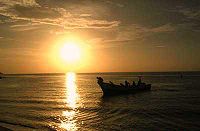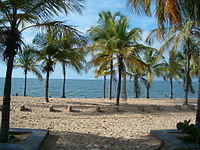- Cumaná
-
For the manufacturer, see Cumana (manufacturer).
Cumaná View of Cumaná

Flag
SealNickname(s): La Tierra Donde Nace El Sol, Primogénita del Continente Americano
(English:"The land where the sun is born, Ancestor of the American Continent")Coordinates: 10°27′23″N 64°10′3″W / 10.45639°N 64.1675°WCoordinates: 10°27′23″N 64°10′3″W / 10.45639°N 64.1675°W Country  Venezuela
VenezuelaState Sucre Municipality Sucre Founded 1522 Government - Mayor Rafael Acuña Area - Total 591 km2 (228.2 sq mi) Elevation 43 m (141 ft) Population - Total 305,000 - Demonym Cumanés Time zone VST Postal code 6101 Area code(s) 0293 Website [2] (Spanish) Cumaná (Spanish pronunciation: [kumaˈna], 305,000 inhabitants) is the capital of Venezuela's Sucre State. It is located 402 km east of Caracas. It was the first settlement founded by Europeans in the mainland America,[1] in 1501 by Franciscan friars, but due to successful attacks by the indigenous people, it had to be refounded several times. For example, in 1521 by a group of Spaniards under the command of Gonzalo de Ocampo re-established it, and again in 1569 Diego Hernández de Serpa had to rebuild it. After Amerindian attacks became less of a threat, the city was on several occasions destroyed by earthquakes. Thus the oldest part of the city is late 17th and 18th century; almost none of the 16th century architecture survived.
 A traditional fisherman's boat called "Peñero" at Mochima National Park.
A traditional fisherman's boat called "Peñero" at Mochima National Park.
The city, located at the mouth of the Manzanares River on the Caribbean coast in the NE of Venezuela, is home to one of five campuses of the Universidad de Oriente and a busy maritime port, home of one of the largest tuna fleets in Venezuela. The city is close to the Mochima National Park which boasts some of Venezuela's finest beaches.
It is also the birthplace of Antonio José de Sucre, one of the paramount leaders of the South American war of independence; and Andrés Eloy Blanco, one of the most important Venezuelan poets.
Attractions
The city features a wide variety of colonial style architecture that is still in excellent condition. A large old Spanish fort, the Castillo de San Antonio de la Eminencia (Castle of Saint Anthony of the Eminence) can be seen from the beach, which is still open to the public. Also surviving is the Castillo de Santa Maria de la Cabeza, which was built in 1669. The Museo del Mar displays marine and maritime artifacts.
Notable people born in Cumaná
- Antonio José de Sucre (1795–1830) – South American independence leader.
- José Antonio Ramos Sucre (1890–1930) – Poet and diplomat.
- Andrés Eloy Blanco (1897–1955) – poet, humorist and politician.
- Brigadier General, D. Juan Francisco Echeto (b. 1799) – Venezuelan patriot who fought for independence at the battles of Tacarigua, Santa Lucía, Sabana Redonda, Bailadores, and Lago de Maracaibo.
- Iñaki Anasagasti (b. 1947) – Spanish politician, member of the Basque Nationalist Party (PNV)
- Francisco Sánchez (b. 1976) – butterfly and freestyle swimmer
- Vanessa Peretti (b. 1986) – first deaf and mute to take part in the Miss Venezuela pageant
- Rafael Betancourt (b. 1975) – relief pitcher for Colorado Rockies
- Armando Galarraga (b. 1982) – starting pitcher for Detroit Tigers, most noble for losing a perfect game on a disputed call (See Armando Galarraga's near perfect game)
- Luis Maza (b. 1980) – shortstop for Los Angeles Dodgers
- César Jiménez (b. 1984) – left-handed relief pitcher for Seattle Mariners
References
- Krzysztof Dydniski & Charlotte Beech, Lonely Planet Venezuela, (2004)
 State capitals of Venezuela
State capitals of VenezuelaCapital, state Bold indicates national capital. Categories:- Populated places in Venezuela
- Sucre (state)
Wikimedia Foundation. 2010.

